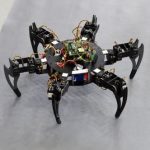 Food
Food  Food
Food  History
History 10 Odd Things Colonial Americans Kept at Home
 Weird Stuff
Weird Stuff 10 Superstitious Beliefs That Once Consumed Entire Cultures
 History
History 10 Bizarre Friendly Fire Incidents in Military History
 Technology
Technology 10 Modern Technologies That Accidentally Imitate Ancient Magic
 Mysteries
Mysteries 10 Mysteries of the Human Genome
 Weird Stuff
Weird Stuff 10 Things So Rare They’ve Only Been Found Once
 History
History 10 Legends Whose Last Moments Undid Their Glory
 Health
Health 10 Futuristic Ideas to Treat Common Medical Problems
 Weird Stuff
Weird Stuff Ten Surreal Attempts to Reverse Baldness
 Food
Food 10 Everyday Foods You Didn’t Know Were Invented by the U.S. Military
 History
History 10 Odd Things Colonial Americans Kept at Home
 Weird Stuff
Weird Stuff 10 Superstitious Beliefs That Once Consumed Entire Cultures
Who's Behind Listverse?

Jamie Frater
Head Editor
Jamie founded Listverse due to an insatiable desire to share fascinating, obscure, and bizarre facts. He has been a guest speaker on numerous national radio and television stations and is a five time published author.
More About Us History
History 10 Bizarre Friendly Fire Incidents in Military History
 Technology
Technology 10 Modern Technologies That Accidentally Imitate Ancient Magic
 Mysteries
Mysteries 10 Mysteries of the Human Genome
 Weird Stuff
Weird Stuff 10 Things So Rare They’ve Only Been Found Once
 History
History 10 Legends Whose Last Moments Undid Their Glory
 Health
Health 10 Futuristic Ideas to Treat Common Medical Problems
 Weird Stuff
Weird Stuff Ten Surreal Attempts to Reverse Baldness
10 World-Changing Ideas Explained First-Hand by Their Creators
Unfortunately, most of the ideas that human beings conceive never go anywhere. This is true even for very good ideas. Many appear briefly, only to fade into obscurity as history marches on. But every so often, an idea emerges that is so bold, visionary, and fundamentally transformative that it cannot be forgotten. These are the ideas that ignite revolutions.
Throughout history, certain individuals have introduced concepts that reshaped how we understand the world and our place within it. From groundbreaking scientific theories to paradigm-shifting technological innovations, these ideas did not merely gain acceptance; they changed the way we live, think, and relate to one another. In this list, we explore ten such world-changing ideas, each introduced by the person who first imagined it. These are the thinkers who dared to see beyond the familiar and, in doing so, changed the course of history.
You’ll recognize many of the names on this list, such as Einstein, Wales, and Hopper. So let’s put on our swim goggles as we take a deep dive into 10 world-changing ideas explained first-hand by their creators.
Related: 10 Inventions That Thrived in Ways Their Creators Never Expected
10 The Thinking Machine
In 1961, American actor David Wayne hosted a historic MIT event produced by CBS as part of its Tomorrow series. Titled “The Thinking Machine,” the program introduced American audiences to a radical and unfamiliar idea: that machines might one day learn to think.
The show opened with Wayne interviewing Professor Jerome D. Wiesner, Director of the Research Laboratory of Electronics at MIT. In one of the most memorable demonstrations, a computer played a game of checkers against a human opponent. At the time, the term artificial intelligence was only beginning to circulate in academic circles. To the general public, the notion that a machine could “think” was strictly science fiction.
The full broadcast featured several of Wiesner’s visionary colleagues, including Claude Shannon and Oliver Selfridge. Shannon, already celebrated as the father of information theory, explained how machines might eventually replicate aspects of human reasoning. He demonstrated a mechanical mouse that could learn to navigate a maze. He spoke calmly of machines that could adapt, solve problems, and even create.
It’s interesting to view this old black-and-white television program today in 2025 with 20/20 hindsight. What seemed so remarkable back then is so commonplace in today’s world, where computer processing power is millions of times greater than it was at the time. Imagine if Professor Wiesner could be brought forward to the present day to see how far his work has progressed.[1]
9 Sal Khan’s Commitment to the Virtual Classroom
Salman “Sal” Khan’s futuristic vision of education led him to create Khan Academy, an online platform that gives students free access to video lessons on a wide range of topics.
In 2004, Khan began tutoring his cousin Nadia over the phone and using Yahoo Doodle Notepad after she had trouble with unit conversions. What started as a simple act of support quickly grew. As more relatives asked for help, he began recording video lessons and uploading them to YouTube so his cousins could learn at their own pace. These early videos, made in a closet on a basic tablet, were informal, clear, and surprisingly effective.
The response was both immediate and huge. Viewers from around the world, including students, teachers, and lifelong learners, began using the videos to learn everything from algebra to art history. Khan left his job as a hedge fund analyst and founded Khan Academy in 2008 with one goal in mind: to provide a free and world-class education for anyone, anywhere, anytime.
Khan Academy wasn’t built to impress investors or chase trends. It was built to help real people solve real problems, and that simple mission is what made it work so well.[2]
8 Carl Sagan’s Contribution to the Golden Record
Carl Sagan is probably the most famous astronomer of all time, and he helped to bring planetary science into the global mainstream.
In 1977, as NASA prepared to launch the Voyager 1 and 2 spacecraft, Sagan proposed a bold idea: send a message into interstellar space representing Earth’s diversity of life and culture. The result was the Golden Record, a gold-plated copper phonograph disc attached to each Voyager probe, designed to last a billion years.
Sagan led a team that curated an unusually intimate archive of 115 images, greetings in 55 languages, music from across cultures, and everyday sounds such as a baby crying, thunder, and a kiss. The musical selections ranged from Bach and Beethoven to Azerbaijani folk music and Javanese gamelan. Together, they created an audio time capsule of human civilization, capturing both intellect and emotion.
The Golden Record was a once-in-a-lifetime gesture that captured the meaning of Earthly human and non-human life for any intelligent beings that might one day find it. Sagan’s vision framed humanity as one species sharing a single planet. The message was clear: We were here, and we reached out in peace.
More than four decades later, both Voyager spacecraft are still traveling through space, carrying the Golden Record farther than any human-made object has ever gone.[3]
7 Jane Goodall Redefined What It Means to Be Human
It’s extremely rare for one person to be recognized as the world’s undisputed expert on anything. Jane Goodall is almost certainly the world’s leading authority on chimpanzees.
In the early 1960s, a young Englishwoman named Jane Goodall arrived at the Gombe Stream Reserve in what is now Tanzania with a bold idea. She wanted to observe chimpanzees as intelligent, emotional beings living in the wild instead of seeing them as mere lab animals. She gave them names instead of numbers, watched them quietly from a distance, and slowly earned their trust. What she saw changed how the world understands animals.
In one observation that made history, Goodall watched a chimp named David Greybeard use a stick to extract termites from a mound. This was clear, undeniable tool use. At the time, scientists believed only humans made and used tools. Goodall proved that was wrong.
Her work reshaped how we think about chimpanzees and raised profound questions about what it means to be human. Chimps form relationships, express grief, fight, and show empathy. Goodall helped the world see animals not as machines driven by instinct but as sentient beings with thoughts and emotions.
More than sixty years later, she is still one of the most respected figures in science and conservation. Through her research and advocacy, she introduced a powerful idea: the gap between humans and other animals is much smaller than we thought.[4]
6 Jimmy Wales Launched the World’s Shared Digital Brain
The world is extremely lucky that Jimmy Wales decided to co-found Wikipedia, the world’s most famous online encyclopedia. In another part of the theoretical multiverse, Wales is living out his life happily as a financial trader. But in our universe, things turned out very differently.
In 2001, Jimmy Wales introduced a brilliant novel idea: building an online encyclopedia that anyone in the world could edit. Initially, it sounded like something that would become a minefield of chaotic misinformation. Traditional encyclopedias were closed, curated by credentialed experts, and guarded behind paywalls. Wales envisioned something entirely different. He imagined a free, ever-evolving repository of human knowledge shaped not by institutions but by global collaboration.
That vision became Wikipedia. And seemingly, a miracle occurred: instead of becoming rife with misinformation, Wikipedia became a surprisingly reliable source of factual information on almost every topic. At first, it seemed laughable to critics. How could an encyclopedia edited by anonymous Internet users ever be accurate or reliable? But Wales had faith in what he called the “wisdom of crowds.” He believed that, given the right tools and guidelines, people would contribute knowledge and self-correct misinformation. And over time, they did.
Wikipedia quickly grew into the largest encyclopedia in history, available in over 300 languages and used by billions. Students, teachers, journalists, researchers, and casual readers rely on it daily. Its open-editing model, once ridiculed, has become a powerful demonstration of decentralized knowledge-sharing. Instead of relying on gatekeepers, the world now participates in the process of curating and preserving its own history and culture.
What Wales launched became much more than a website; it became a global movement. He introduced the concept that knowledge should be free, accessible, and collectively owned.[5]
5 Grace Hopper Taught Computers to Speak English
Grace Hopper had a remarkably long and accomplished career in the United States Navy, spanning 42 years, including multiple retirements and returns to service. She eventually rose to the rank of rear admiral and was a premier computer scientist who greatly advanced the field. She was one of the inventors of the COBOL programming language, which remains widely used in the banking industry, even today, in 2025.
In the early days of computing, machines spoke only in binary ones (relatively high voltage, such as 5 volts) and zeros (relatively low voltage, such as zero volts). Programming them required fluency in binary or assembly code, languages so cryptic that only a small circle of specialists really understood them. But Rear Admiral Grace Hopper had a compelling new idea: what if computers could fully understand English?
Hopper, a mathematician and Navy officer, believed programming should be accessible to everyone, not just elite engineers. In the 1950s, she developed one of the first compilers, a tool that translates human-readable instructions into machine code. Her compiler eventually led to the creation of COBOL, a programming language designed to resemble plain English. Instead of writing code like MOV AX, BX, programmers could write something like ADD HOURS TO TOTAL.
Grace Hopper started a philosophical shift in how computers were programmed. Her work democratized computing by making it understandable to the average person. Businesspeople, educators, and non-specialists could now write software without needing to speak the language of the machine. Computers were no longer the sole domain of physicists and mathematicians; they became tools anyone could use to solve real-world problems.
Grace Hopper taught the world that computing should serve people, not the other way around. Her insistence on human-centered programming changed everything: Nearly every modern language, from Python to C to Rust, follows the path that she pioneered many decades ago.[6]
4 FreeBSD: Jordan Hubbard’s Open Computer Operating System
FreeBSD is the world’s second most well-known open-source computer operating system—after Linux, of course.
In the early 1990s, the UNIX operating system was powerful but closed-source, and the world of computing was still dominated by expensive, proprietary software. That’s when Jordan Hubbard, a software engineer and systems administrator, introduced an idea that helped break that model open: a free and open-source version of UNIX that anyone could use, modify, and share. The result was FreeBSD.
Hubbard co-founded the FreeBSD Project in 1993 with a small group of like-minded developers who believed that high-performance, stable software should not be locked behind corporate paywalls. Built on the foundation of the original Berkeley Software Distribution (BSD), FreeBSD took the ideals of UNIX, such as modularity, multi-user support, and network robustness, and made them accessible to anyone with a computer and curiosity.
What made FreeBSD revolutionary was its combination of technical excellence and openness. Developers around the world could contribute to the project, improve on it, and build on top of it. This created a ripple effect: companies like Netflix, Sony, and Juniper Networks eventually adopted FreeBSD for their backend systems. Apple even used its core components as the basis for macOS’s foundation, known as Darwin.
Jordan Hubbard contributed to making UNIX flexible, scalable, and a living computer operating system. He introduced the concept that operating systems, once controlled by institutions, could thrive as global collaborations. In doing so, he laid the groundwork for the open-source movement that powers much of today’s Internet.[7]
3 Ken Thompson and Dennis Ritchie Built UNIX to Last Forever
In the late 1960s, at Bell Labs, two programmers, Ken Thompson and Dennis Ritchie, set out to solve a straightforward problem: how to create an elegant, portable, and efficient computing environment. What they ended up building, almost quietly, was UNIX. This operating system would shape the future of computing for decades to come.
UNIX was transformative because of its simplicity and modular design. Each program did one thing and did it well. This minimalist philosophy allowed users to combine small tools in powerful ways. This concept remains central to all modern systems. But what truly set UNIX apart was its portability. Thanks to Ritchie’s development of the C programming language, UNIX could be recompiled and run on different machines, which was virtually unheard of then.
As universities, research labs, and eventually corporations adopted UNIX, its influence spread rapidly. It became the foundation for countless modern operating systems, including Linux, macOS, Android, and the BSD family. Today, nearly every smartphone, server, and supercomputer relies on ideas first introduced in UNIX.
In UNIX, Thompson and Ritchie created a new model of computer operating system software, along with a new way of thinking about operating systems, what they could do, and how they would do it. They believed powerful computing should be clean, flexible, and shared. The UNIX philosophy is very much alive today.[8]
2 David Deutsch Reimagines Quantum Computation
In the 1980s, British physicist David Deutsch asked a bold question: what if a computer could perform many calculations at once, not by running faster, but by existing in multiple states at the same time? The idea came from quantum mechanics, which describes how matter behaves at the subatomic level. Deutsch believed its principles could be used to build a completely new kind of computer.
Building on Alan Turing’s work, Deutsch proposed a universal quantum computer. Classical machines use bits that are either 0 or 1. Quantum computers use qubits, which can be both at once. This feature, called superposition, lets them explore many possibilities in parallel. Qubits can also be entangled, meaning a change to one instantly affects the other, even at a distance. Together, superposition and entanglement allow quantum computers to solve certain problems far beyond the reach of classical machines.
One real-world example is breaking encryption. Most digital security relies on how hard it is for a regular computer to break large numbers into prime factors. That process takes too long to be practical. But a quantum computer, using a method called Shor’s algorithm, could do it much faster. What might take a classical computer thousands of years could be done in hours by a powerful quantum computer.
Deutsch also explored the meaning behind these capabilities. He argued that quantum computing points to a multiverse where all possible outcomes exist in parallel. In this view, a quantum computer does not just work efficiently. It draws power from many versions of reality running side by side.
Quantum computers are still in development but are already being used in cryptography, chemistry, and optimization, where classical systems struggle. At the heart of this progress is Deutsch’s idea: computing may open a path to the deeper structure of reality.[9]
1 Albert Einstein Explains Space, Time, Mass and Energy
Albert Einstein is widely regarded as the most famous physicist in history. In 1905, while working as a 26-year-old patent clerk, he published a paper that changed how we understand the universe. His theory of special relativity introduced a bold idea: space and time are not fixed and separate but instead form a single, flexible fabric known as spacetime.
Einstein showed that time slows down and lengths shorten as objects move closer to the speed of light (about 186,000 miles per second, or about 300,000 kilometers per second). He proved that the speed of light is the same for all observers, regardless of how fast they move. This challenged the Newtonian view of absolute space and time, replacing it with a world where motion and measurement depend on your frame of reference. He also introduced the famous equation E = mc², which revealed that mass and energy are two forms of the same thing.
In 1915, Einstein expanded his theory into general relativity. He proposed that gravity is not a force but the result of curved spacetime. Massive objects like the Sun bend the spacetime around them, and smaller objects move along those curves. This was confirmed in 1919 when scientists observed starlight bending around the Sun during a solar eclipse, just as Einstein predicted.
Relativity completely and permanently changed humanity’s understanding of the universe. The concept of relativity guides our understanding of real phenomena such as black holes, the time differences experienced by orbiting satellites, and the redshift of light from distant galaxies.[10]








